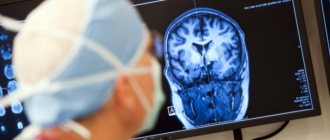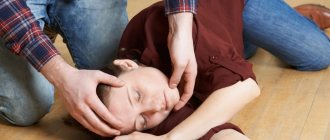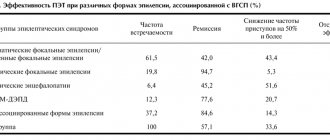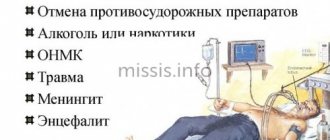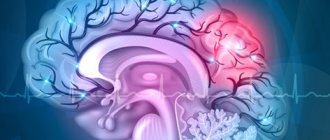The Moscow mental health center “Leto” provides a full range of techniques for identifying and treating psychoneurological diseases. To do this, we use modern equipment and drugs with minimal side effects. Our doctors have a high level of theoretical training and rich practical experience. If you or your relatives have night sleep epilepsy, then by contacting our clinic, you will receive qualified help and get rid of the manifestations of the disease. Not only residents of Moscow, but also representatives of other regions and citizens of other countries come to us for treatment. We try to help all people in need of healing and find an individual approach to each client. Those who have undergone treatment leave positive reviews and, if necessary, contact us again.
What is the difference between epilepsy at night?
Attacks in adults are less severe compared to daytime episodes. Convulsions are completely absent, or are expressed smoothed out in the form of chaotic oscillatory movements of the arms and legs. This circumstance is explained by the low activity of the central nervous system at night. During this period of the day, the human brain reacts minimally to incoming external and internal stimuli.
The clinical classification of paroxysmal manifestations takes into account the sleep phase.
So the following variants of epileptic seizures are distinguished:
- Early. Occurs within the first 2 hours after
the man falls asleep. - Pre-dawn. Before waking up, basic functions in the brain begin to activate and against this background, manifestations of the disease may develop.
- Morning. Characteristic of cases of forced awakening (alarm clock, phone call, physical impact, voice).
Daytime sleep attacks can also be included in this group.
Knowing these features, the medical staff of the Leto clinic monitors clients with this pathology most carefully in order to prevent possible complications.
Institute of Child Neurology and Epilepsy
Epilepsy is a brain disease characterized by repeated unprovoked seizures with impaired motor, sensory, autonomic or mental functions. Attacks can occur at any time of the day, however, in some patients they occur during sleep. There is even a separate option - sleep epilepsy. In this case, attacks occur only at night. Particularly typical for these patients is the occurrence of attacks when falling asleep, waking up, or while awake, immediately after waking up. This type of epilepsy can be quite difficult to diagnose because there are often no witnesses to the seizures if patients sleep alone in a room.
In some patients, nocturnal attacks begin with an aura in the form of sudden awakening, “squelching” sounds; trembling of the whole body may occur, headache, vomiting, forced turning of the head and eyes to the side, convulsions of individual parts of the body, distortion of the face, drooling, speech impairment. Sometimes patients sit or get on all fours and make “pedaling” movements, reminiscent of riding a bicycle. The attack lasts on average from 10 seconds to several minutes. Some patients retain memory during attacks and can describe them. Indirect signs of an attack that occurred at night are: biting the tongue and gums, the presence of foam with blood on the pillow, involuntary urination, muscle pain, abrasions and bruises on the skin. After an attack, patients may wake up on the floor.
There is another problem for patients with epilepsy related to sleep. Sleep is an integral process of our life, during which the entire body, including the nervous system, rests. In most patients with epilepsy, reduced sleep (deprivation) can lead to the occurrence and frequency of seizures. Sleep deprivation includes late going to bed, frequent awakenings at night, and unusually early awakening. Particularly dangerous is systematic late going to bed, as well as occasional refusal to sleep (for example, in connection with night shifts or “parties”). This leads to exhaustion of the nervous system and vulnerability of the nerve cells of the brain with increased convulsive readiness. Traveling with disruption of the sleep-wake rhythm is also dangerous. For patients with epilepsy, changing time zones for more than 2 hours is undesirable.
A sudden, abrupt “forced” awakening (for example, when an alarm clock rings early) can also provoke the appearance of epileptic seizures.
We should not forget that other clinical manifestations that have no connection with epilepsy may occur during sleep. These are night terrors, nightmares, sleepwalking and sleep talking, urinary incontinence and others. Night terrors are especially often confused with epileptic paroxysms. In this case, the child suddenly sits up, cries, screams, sweating, dilated pupils, and chills are noted. He does not respond to his parents’ appeals and pushes them away; there is a grimace of horror on his face. After about five minutes the child calms down and falls asleep. The events of the night are forgotten after waking up. Unlike epilepsy, seizures never occur.
Most children and young adults, when falling asleep, occasionally experience single muscle twitches, accompanied by a sensation of falling and interrupting the incipient sleep. These jerks (benign sleep myoclonus) are usually instantaneous, arrhythmic and asynchronous, of small amplitude. No treatment required.
Narcolepsy is a condition characterized by sudden episodes of falling asleep during the day. This is a rare disease. It is not accompanied by epileptiform changes on the EEG.
If there is a suspicion of nocturnal attacks, it is necessary to conduct an examination, especially important - sleep EEG and nighttime video-EEG monitoring, which are often carried out after a sleep deprivation test. This is important for establishing the correct diagnosis and choosing treatment. Unfortunately, many patients with nocturnal seizures refuse to take antiepileptic drugs. This is a very serious mistake. On the one hand, refusal of treatment for epilepsy can lead to progression of the disease and increased frequency of attacks. On the other hand, in no case will the doctor give a guarantee that attacks, occurring for many years only at night, in the absence of adequate treatment, will not appear during the daytime.
Nocturnal attacks of epilepsy, manifestations
Paroxysm may have a convulsive component
Tom, and without him. The grand mal attack looks classic. It begins with a phase of the tonic component, in which the patient’s body and lower limbs are stretched, arms are pressed to the chest, muscles spasm, and breathing is impaired.
After about a minute, the clonic phase develops. The patient moves his limbs tensely and chaotically. The muscles of the neck and torso are in a contracted state. Breathing is hoarse, foam and blood may come out of the mouth, and sphincter disorders are observed. After a few minutes, the painful process subsides. An epileptic, as a rule, does not know and does not remember his attacks, especially those that occur in a dream.
Knowing about his illness, he independently identifies the signs of a seizure as a result of detecting:
- Rumpled and crumpled bed.
- Stains of blood and saliva.
- Traces of feces.
Sometimes before the onset of an epileptic attack, patients wake up with a feeling of fear, experience a sharp headache, nausea, and vomiting. Seizures can occur several times during the night.
Main symptoms of seizures (psychogenic non-epileptic)
Pseudo-seizures, as a rule, completely imitate an epileptic attack - they can be accompanied by various characteristic physical and somatic symptoms:
- dilated pupils;
- involuntary urination;
- defecation;
- tongue bite;
- angina attack;
- asthma attack and much more.
And most importantly, they are also felt by patients as a true seizure.
You can understand whether this is an attack or not only by recording this event during video EEG monitoring.
Symptoms of psychogenic non-epileptic seizures are most often a reflection of a psychological personality conflict or mental disorder.
Most patients with pseudoseizures have psychiatric comorbidities
- anxiety-depressive disorder,
- somatoform disorder,
- conversion disorder,
- panic attacks,
- chronic pain and others.
Causes of epilepsy at night
Why the symptoms of the disease appear during the dark period of the day still remains an open question. But based on practical observations, psychiatrists at our mental health center have identified a number of factors that provoke exacerbation.
These include:
- Insufficient duration of rest, chronic lack of sleep.
- A state of prolonged stress.
- Abuse of drinks containing alcohol, smoking.
- Taking psychoactive substances, including medications.
- Head injuries, previous surgical interventions.
- The presence of epilepsy in close relatives.
In a child, an attack can be triggered by:
- Overexcitement before falling asleep.
- Loud noise at night.
- Lack of fresh air.
- High or low temperature in the sleeping area.
- Violent awakening.
Similar causes leading to a seizure are also identified in adolescents. To these is added watching a movie in the evening that causes a mental reaction and excitement.
Diagnostics
If your loved ones, children, or acquaintances have suspicious symptoms, we suggest undergoing a diagnostic examination at our Leto clinic. Experienced specialists will assess the patient’s condition and accurately establish a diagnosis so that the subsequent selection of treatment will lead to a positive result.
To make an appointment with a doctor, make a preliminary call at the phone number listed on the website. The receptionist on duty will register the client at a suitable time.
The initial consultation includes:
- Survey and find out the essence of the problem that has arisen.
- Examination with assessment of all data on the condition, including neurological status, identifying signs characteristic of epilepsy.
- Clarification of all the details of existing epileptic attacks: frequency of occurrence, duration, other features.
After the medical examination you will need to undergo:
Magnetic resonance imaging (MRI). It will allow us to identify oncological processes, structural features of the brain, the presence of consequences of hemorrhages, vascular anomalies, and other changes that lead to problems.- Electroencephalography (EEG). Removal of biopotentials makes it possible to accurately identify the paroxysmal predisposition of the nervous system and establish the variant of the disease.
- Positron emission tomography (PET). The technique is prescribed to patients with metabolic and metabolic disorders in the body to assess metabolic processes in brain tissue, to confirm the found formations in controversial cases.
If the patient has concomitant ailments, the clinic can provide consultations with other specialists.
All procedures are necessary to clarify and confirm the diagnosis.
How common are psychogenic (non-epileptic) seizures?
Their prevalence is quite high: on average, 5-10% of all patients observed on an outpatient basis with a diagnosis of epilepsy suffer from a false disease.
It is also sad that almost a third of patients with drug-resistant epilepsy are not correctly diagnosed because they suffer from a form of psychogenic non-epileptic seizures.
- Most often, young and middle-aged women suffer from pseudo-attacks (the prevalence is slightly more than 70% among all cases of PNEP).
- Less commonly, children and adolescents of both sexes are affected equally.
- It is also worth noting that the presence of PNEP does not negate the diagnosis of epilepsy. About 10% of all patients have true epileptic seizures with abnormal activity of brain structures.
PNEP is a type of change in human behavior that is outwardly similar to the manifestations of various forms of epileptic seizures. But it is not associated with abnormal bioelectrical activity of the brain, but is a manifestation of various types of mental disorders.
The presence or absence of abnormal bioelectrical activity of the brain can only be seen using EEG monitoring.
and you can sign up for the study by calling: +7
Treatment
After consultation and examination, psychiatrists at the Leto clinic will offer you the most suitable treatment option. In uncomplicated cases, you can get by with an outpatient selection of the necessary medications to take at home. In more complex situations, hospitalization cannot be avoided.
We offer you comfortable conditions in our hospital rooms. 24-hour supervision allows you to use all treatment procedures with maximum efficiency.
The treatment plan is selected individually and includes:
Prescribing drugs to relieve pain from attacks in the presence of pain using anticonvulsants or painkillers, as well as taking prunes, which contain a lot of calcium. This element is able to reduce the number of convulsive episodes and has the ability to relieve pain.- Prevention and reduction of the frequency of new paroxysms. The goal is achieved by consuming foods that are part of the ketogenic diet.
- Reducing the duration of residual seizures.
- Gradually reduce the dose of medication after the seizures disappear.
Pharmaceutical drugs are selected in such a way as to minimize the possible side effects of anticonvulsants.
Nocturnal sleep epilepsy must be eliminated by prescribing special anticonvulsants. The selection of anticonvulsants begins with the selection of one name. If necessary, two or more pharmaceuticals are introduced into the treatment regimen.
Most often used:
- Carbamazepine.
- Clonazepam.
- Phenytoin.
- Lamotrigine.
If the selection and combination of pharmacotherapy does not give the expected result, then electrical stimulation of the vagus nerve is prescribed.
As an additional treatment option, the Vojta physiotherapeutic method is used, based on the normalization of nerve connections. This technique can be taught to the patient’s relatives, and they will be able to use it at home independently after discharge from the hospital.
How to provide assistance?
Here are some recommendations that will allow you to save the patient:
- Remove all solid objects placed near the person.
- Place a soft object under the patient's head and turn it on its side so that the foam flows out to the side.
- Free the person from tight clothing.
- An object like a spoon should be placed between the teeth, which will be hidden in clean gauze so that the patient does not damage his tongue during a seizure.
- Do not hold, touch or jerk the patient in any way.
- Note the time the seizure started so you can immediately determine the length of time it lasted. This information is necessary for emergency physicians.
- Be sure to call an ambulance!
Cost of services
| CONSULTATIONS OF SPECIALISTS | |
| Initial consultation with a psychiatrist (60 min.) | 6,000 rub. |
| Repeated consultation | 5,000 rub. |
| Consultation with a psychiatrist-narcologist (60 min.) | 5,000 rub. |
| Consultation with a psychologist | 3,500 rub. |
| Consultation with Gromova E.V. (50 minutes) | 12,000 rub. |
| PSYCHOTHERAPY | |
| Psychotherapy (session) | 7,000 rub. |
| Psychotherapy (5 sessions) | 30,000 rub. |
| Psychotherapy (10 sessions) | 60,000 rub. |
| Group psychotherapy (3-7 people) | 3,500 rub. |
| Psychotherapy session with E.V. Gromova (50 minutes) | 12,000 rub. |
| TREATMENT IN A HOSPITAL | |
| Ward for 4 persons | 10,000 rub./day |
| Ward for 3 persons | 13,000 rub./day |
| Ward 1 bed VIP | 23,000 rub./day |
| Individual post | 5,000 rub. |
| PETE | 15,000 rub./day |
This list does not contain all prices for services provided by our clinic. The full price list can be found on the “Prices” , or by calling: 8(969)060-93-93. Initial consultation is FREE!
Preventing seizures
Epileptic seizures that occur at night are easier for patients to tolerate. The effectiveness of drug therapy also gives more significant results. After treatment is completed at our mental health center, we offer patients recommendations to reduce the likelihood of symptoms returning.
Clients should adhere to the following rules:
Normalize sleep and rest patterns. Sleep at least 8 hours a day, go to bed and get up at a certain time.- Provide the opportunity to rest for at least 1 hour during the day.
- In the evening, do not watch TV for a long time, especially with programs and films that carry negative information.
- Do not play computer games or talk on the phone for a long time.
- Before going to bed, calm down and think about something pleasant.
- Sleep in a ventilated room with the curtains closed.
- Avoid drinking alcohol and smoking completely.
- Do moderate intensity physical activity. Strictly avoid overloading.
- If you have the slightest suspicion of resumption of epileptic seizures, consult a doctor immediately.
Causes of epileptic seizures
According to official data, approximately 40 million people worldwide suffer from epilepsy. About 5% experience a seizure once, while the rest experience symptoms regularly. The causes of epilepsy vary from person to person.
Factors that provoke the appearance of epileptic seizures:
- impaired metabolism
- overwork
- watching TV for a long time
- long periods of work at the computer
- heat
- intoxication of the body
- alcohol and drug use
- stress
- sleep disorders
Possible causes of acquired epilepsy:
- a brain tumor
- traumatic brain injuries
- brain infections
- cerebral paralysis
- bad ecology
- inflammatory processes in the brain
- brain bleeding
- thromboembolism
- unhealthy brain vessels
- encephalitis
- Alzheimer's disease
- birth injuries
- mental disorders
- heredity


